Black widow spiders are known for their striking appearance and potent venom. When a black widow bites a person, it can lead to various health issues. The bite injects neurotoxins into the body, causing pain, muscle cramps, and other symptoms that can last for several days.
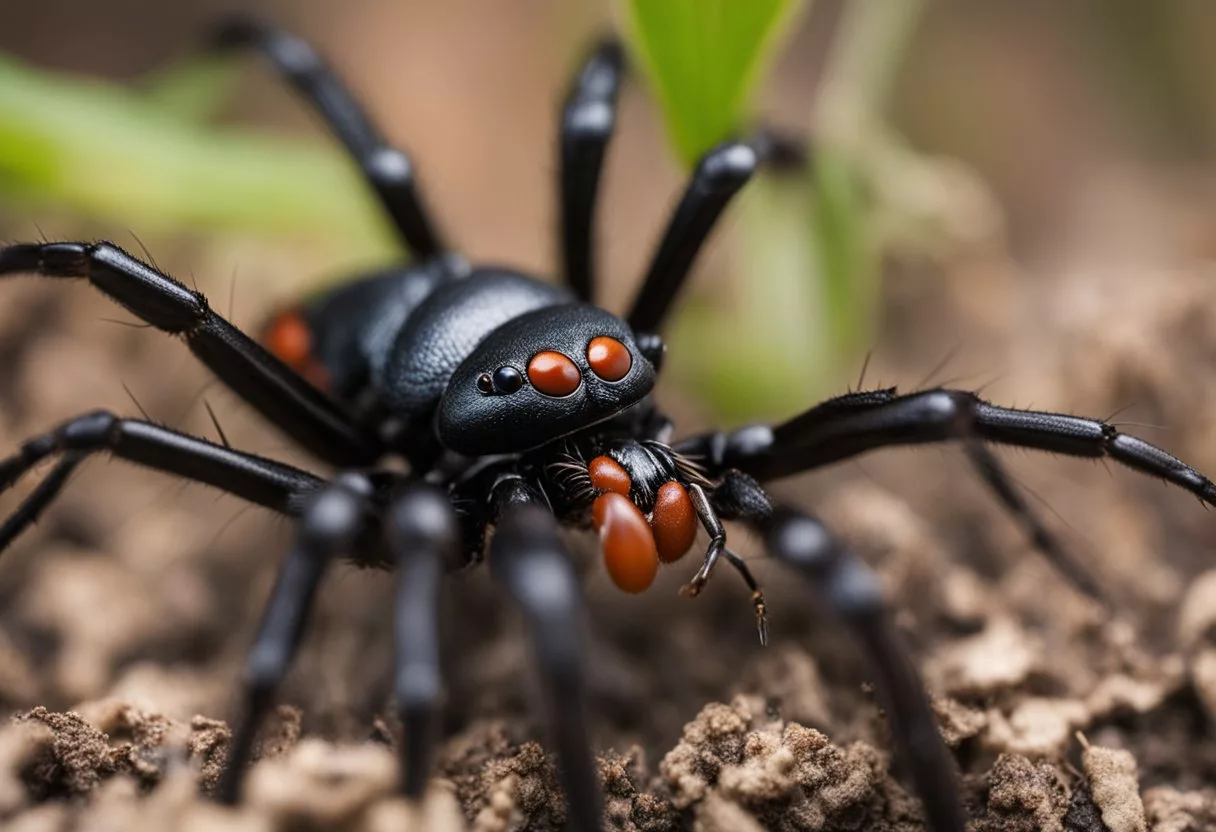
These spiders are found throughout the United States, often hiding in dark, secluded areas. While bites are rare, they can happen when a person accidentally disturbs the spider’s habitat. The effects of a bite can vary from mild discomfort to more severe reactions, depending on factors like the amount of venom injected and the person’s overall health.
Knowing what to do after a black widow spider bite is crucial. Quick action and proper treatment can help manage symptoms and prevent complications. It’s important to stay calm and seek medical help if you suspect a black widow has bitten you.
Key Takeaways
- Black widow spider bites inject neurotoxins that cause pain and muscle cramps.
- Bites are rare but can occur when disturbing the spider’s habitat.
- Seeking prompt medical attention is crucial for managing bite symptoms.
Identification of Black Widow Spiders
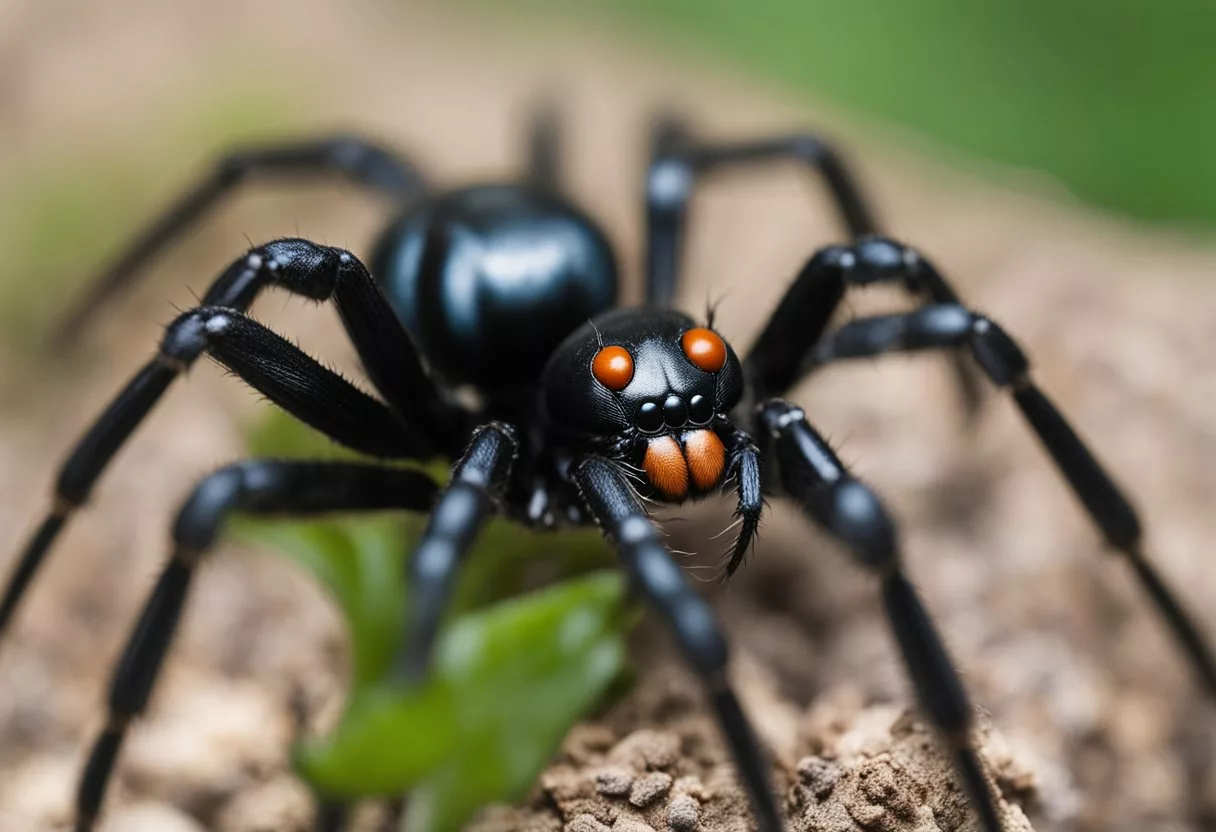
Black widow spiders have unique features that make them easy to spot. Knowing what they look like and where they live can help you avoid dangerous bites.
Physical Characteristics
Black widow spiders are small but striking. Female black widows are about 1.5 inches long, including their legs. They have a shiny black body with a bright red hourglass shape on their belly. This red mark is their most famous feature.
Male black widows are smaller and lighter in color. They may have red or pink spots on their backs. Black widows have eight eyes in two rows. Their legs are thin and long compared to their body size.
These spiders spin messy, strong webs. The webs don’t have a clear pattern like other spider webs. Black widows often hide in the center of their webs.
Habitat and Distribution
Black widow spiders live in many parts of the United States. They are most common in the South. These spiders can also be found in parts of Canada.
Black widows like dark, quiet spots. They often make homes in:
- Garages
- Sheds
- Woodpiles
- Under rocks
- Inside old shoes or boxes
In houses, they may hide in dark corners or behind furniture. Outside, they prefer warm climates but can survive in cooler areas too.
Black widows don’t like to be disturbed. They usually bite only when they feel threatened. Knowing where they live can help people avoid contact and stay safe.
Mechanism of the Black Widow Bite
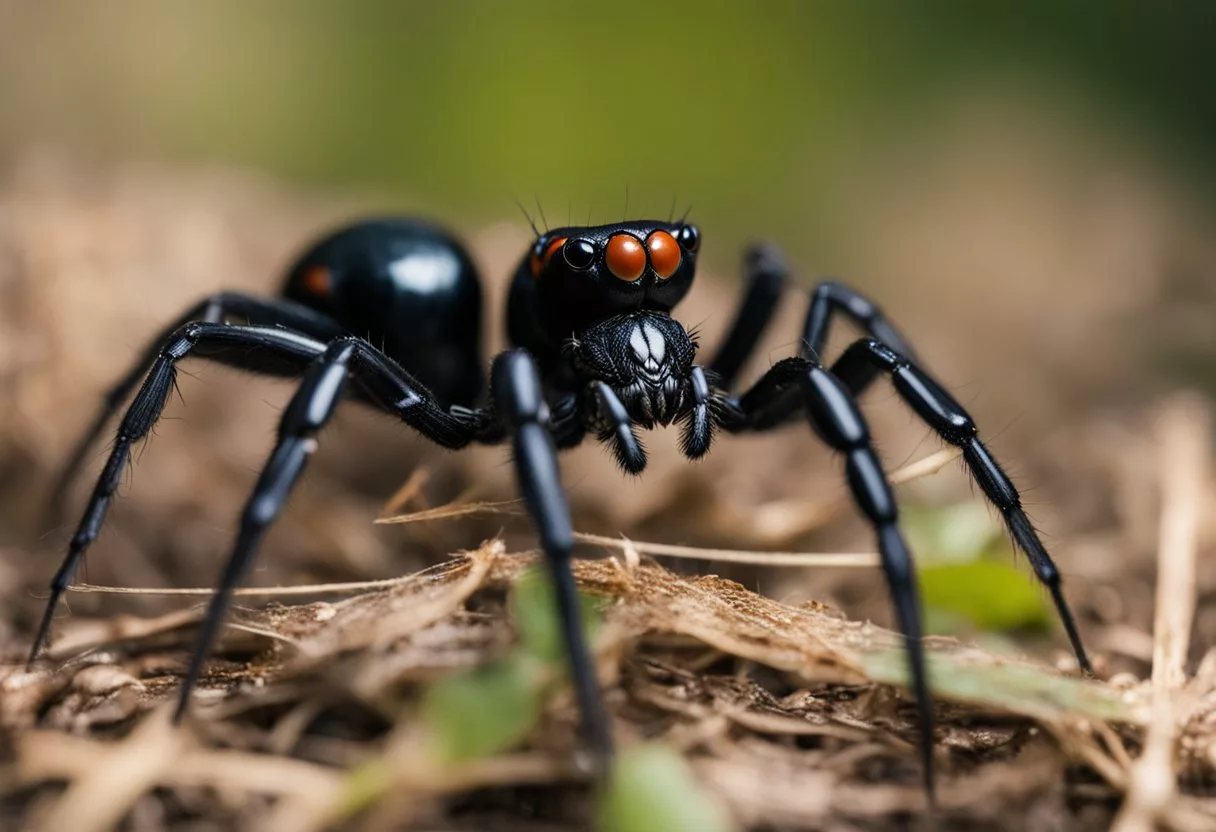
Black widow spiders use venom to subdue prey and defend themselves. Their bite involves a complex process of venom injection that can cause pain and other symptoms in humans.
Venom Composition
Black widow venom contains powerful neurotoxins. The main toxin is alpha-latrotoxin, which affects nerve cells. This toxin makes nerves release large amounts of chemical signals called neurotransmitters.
The venom also has other proteins and compounds. These work together to create the effects of a black widow bite. The mixture is very potent, even in small amounts.
Black widows produce this venom in special glands. The glands connect to their fangs, allowing quick delivery when biting.
Bite and Injection Process
When a black widow bites, it uses its fangs to pierce the skin. The fangs are hollow and connected to venom glands. As the spider bites, muscles squeeze the glands to push venom through the fangs.
The bite itself may not be very noticeable at first. Fang marks might be hard to see. They often look like two tiny red spots.
After the bite, venom spreads into nearby tissues. It then moves through the body in the blood. This process can lead to widespread effects as the venom interacts with nerves and muscles.
Pain usually starts within an hour of the bite. It often gets worse over time as the venom spreads. The pain can be severe and may last for several days.
Symptoms of a Black Widow Spider Bite
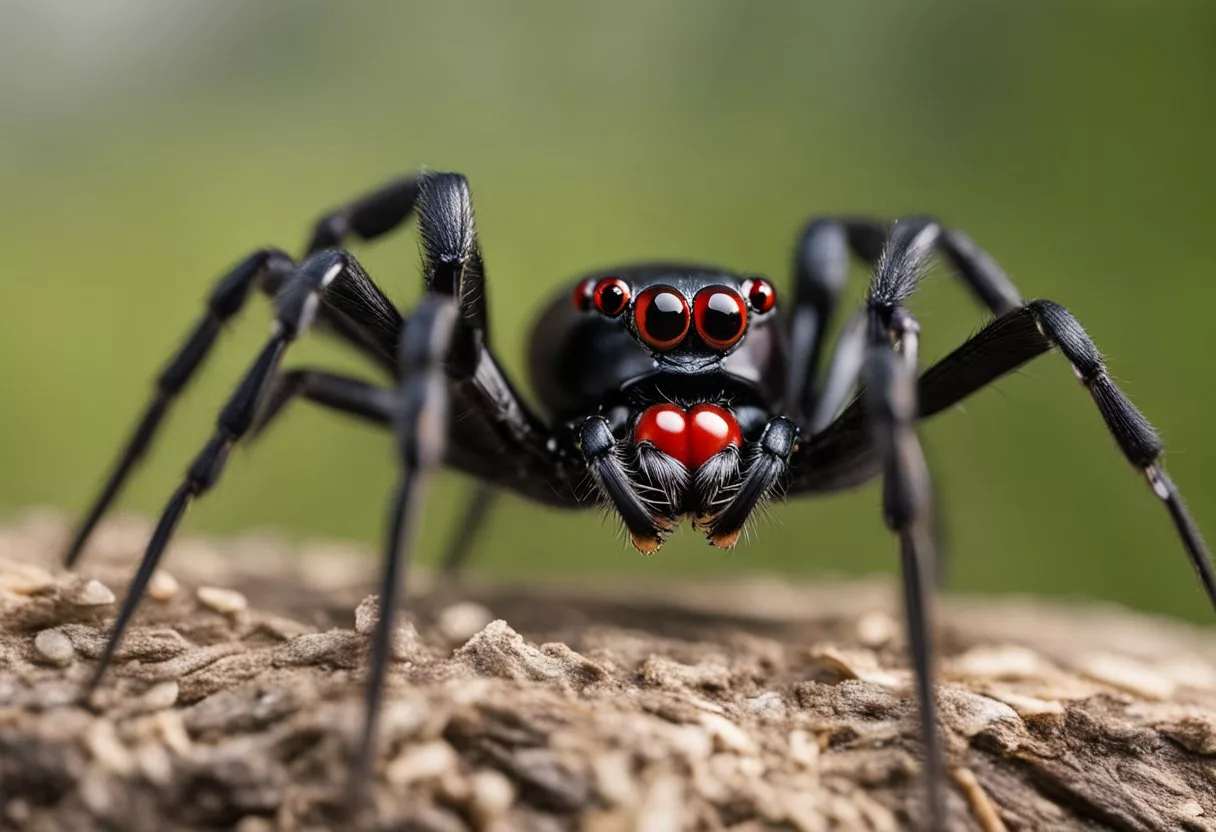
Black widow spider bites can cause a range of symptoms. These can start mild but may become severe. The signs often appear within a few hours after the bite.
Immediate Physical Reactions
Black widow spider bites usually cause pain right away. The pain can be sharp or dull. It may spread to other parts of the body.
The bite area often turns red and swells. A person might see two small fang marks. These marks can be hard to spot.
Some people feel burning or itching at the bite site. Others may not notice much at first.
Systemic Symptoms
As time passes, more symptoms can appear. These affect the whole body, not just the bite area.
Common systemic symptoms include:
- Nausea and vomiting
- Headache
- Sweating
- Muscle cramps, especially in the belly
- High blood pressure
People might also feel weak or dizzy. Some have trouble walking. Breathing can become hard or painful.
Severe Symptoms
In rare cases, symptoms can become very bad. This is more likely in young children, older adults, and people with health problems.
Severe symptoms may include:
- Intense muscle spasms and cramps
- Trouble breathing
- Fever and chills
- Severe pain that spreads
- Restlessness and anxiety
These symptoms need quick medical care. Without treatment, they can get worse fast. In very rare cases, black widow bites can even be deadly.
First Aid and Home Treatment
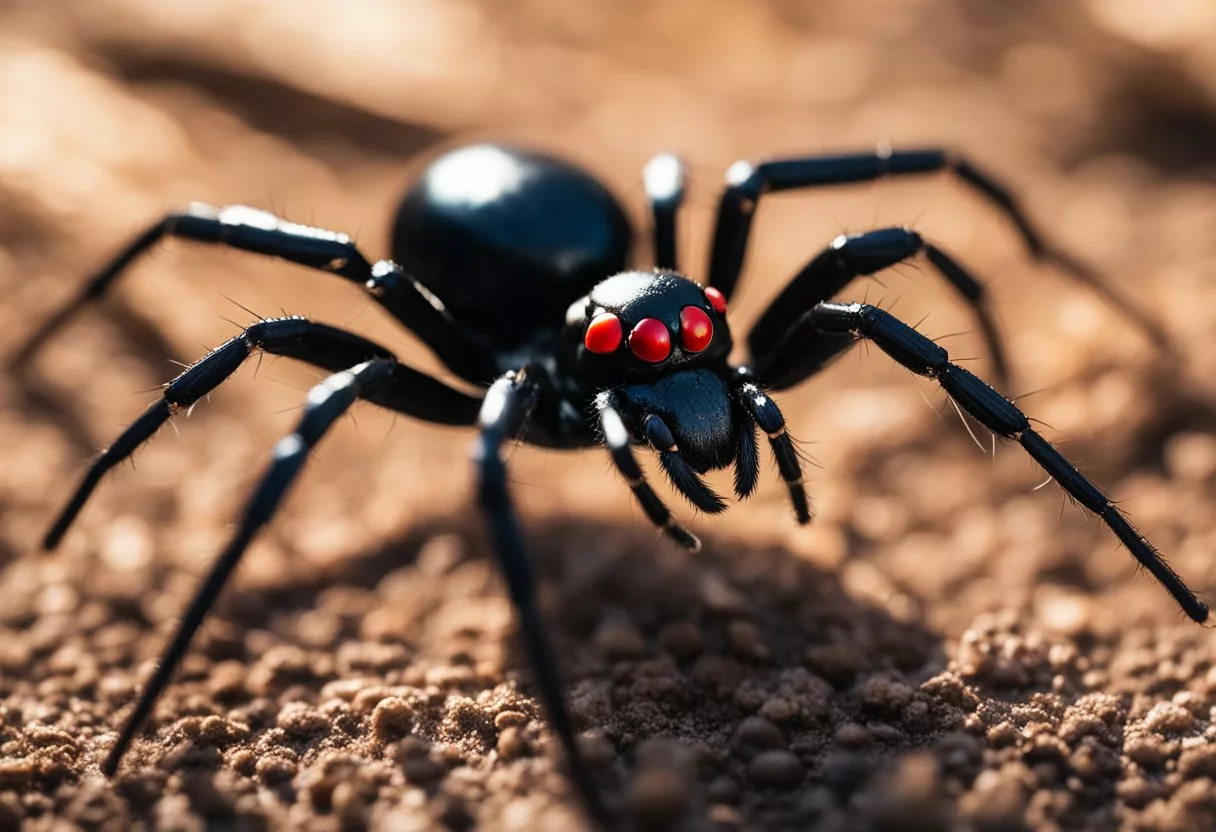
Quick action and proper care can help manage a black widow spider bite. Knowing the right steps to take at home is crucial for reducing pain and preventing complications.
Immediate Steps After a Bite
Clean the bite area with soap and water. This helps remove any venom on the skin surface. Apply an ice pack to the bite site for 10 minutes at a time. This can help reduce pain and swelling.
Elevate the affected limb if possible. This can help minimize swelling. Loosen tight clothing near the bite area to prevent restriction if swelling occurs.
Capture the spider if it’s safe to do so. This can help with identification by medical professionals. Don’t try to catch it if doing so puts you at risk of another bite.
Home Remedies
Use over-the-counter pain relievers like acetaminophen or ibuprofen to manage pain. Follow the dosage instructions on the package carefully.
Apply a cold compress to the bite area for 15 minutes every hour. This can help reduce pain and swelling. Wrap the ice pack in a thin towel to protect your skin.
Keep the bite area clean and dry. Watch for signs of infection like increased redness, warmth, or pus. Avoid scratching the bite site to prevent introducing bacteria.
Stay hydrated by drinking plenty of water. This can help your body process the venom more effectively. Rest and avoid strenuous activity to help your body recover.
When to Seek Medical Attention
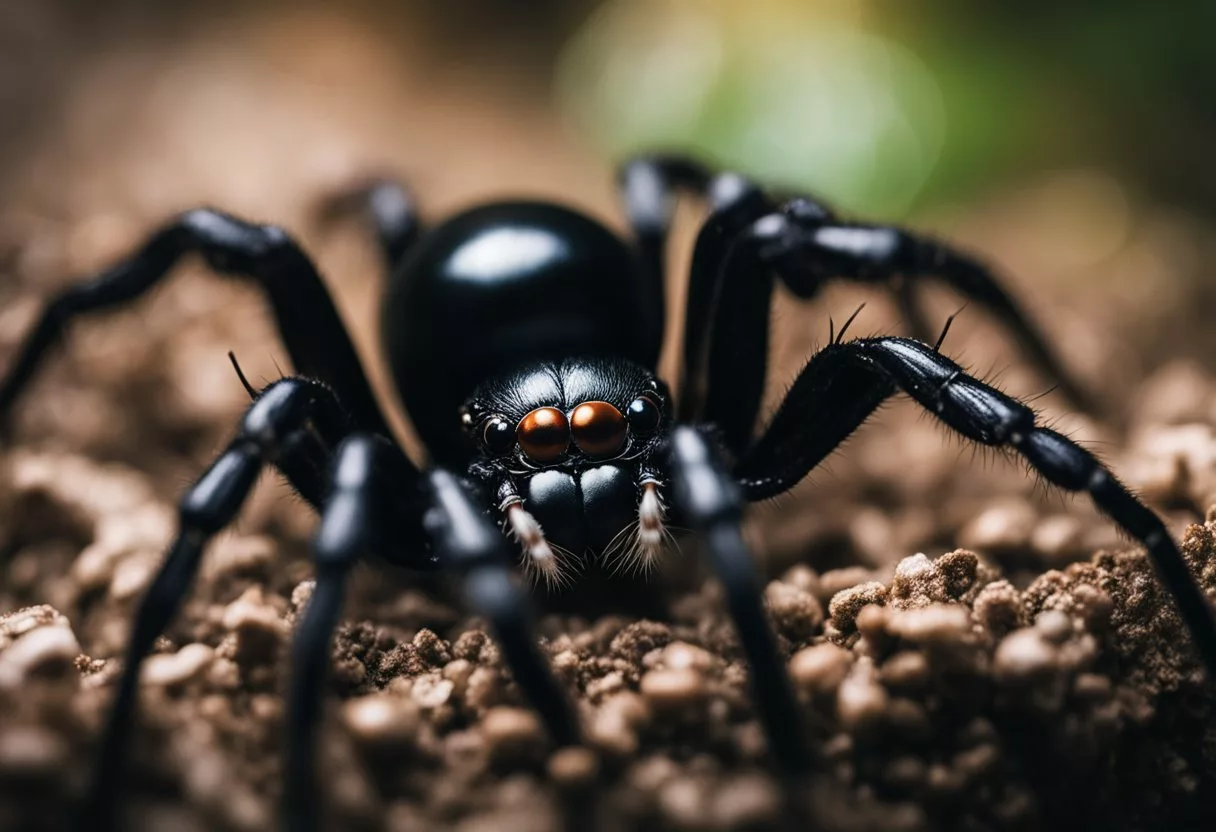
Black widow spider bites can be dangerous. Knowing when to get help is key. Some people face higher risks from these bites.
Signs of Severe Reactions
Severe symptoms may appear within hours of a bite. Watch for:
• Intense pain spreading from the bite
• Muscle cramps or spasms
• Trouble breathing
• High blood pressure
• Nausea or vomiting
• Severe sweating
If any of these occur, seek medical help right away. Call 911 or go to the emergency room. These signs can mean the venom is affecting the body badly.
Don’t wait if symptoms get worse. Quick treatment can prevent serious problems.
High-Risk Groups
Some people need medical care faster after a black widow bite. These groups include:
• Children and older adults • People with heart problems • Those with high blood pressure • Pregnant women
These groups may have worse reactions to the venom. They should see a doctor even if symptoms seem mild.
It’s smart to call a poison control center for advice. They can guide you on what to do next.
Remember, most bites aren’t deadly. But it’s better to be safe and get checked if you’re worried.
Medical Treatment for Black Widow Bites
Black widow spider bites need quick medical care. Doctors use antivenom and other treatments to help patients feel better and avoid problems.
Antivenom Administration
Antivenom is the main treatment for bad black widow bites. Doctors give it through an IV in the hospital. The antivenom stops the spider’s venom from hurting the body more.
Not everyone needs antivenom. Doctors use it for:
- Very bad pain
- High blood pressure
- Breathing trouble
- Pregnant women
- Young kids or older adults
The antivenom works fast. Most people feel better in about 30 minutes.
Supportive Care
Along with antivenom, doctors give other care to help patients get better. This includes:
- Pain medicine to ease discomfort
- Drugs to lower blood pressure if it’s too high
- Muscle relaxants for stiffness and cramps
- IV fluids to prevent dehydration
Doctors watch patients closely for signs of allergic reactions or other problems. They treat any new issues that come up.
Most people with black widow bites get better in a few days with good care. Some might need to stay in the hospital longer if they have bad symptoms.
Prognosis and Complications
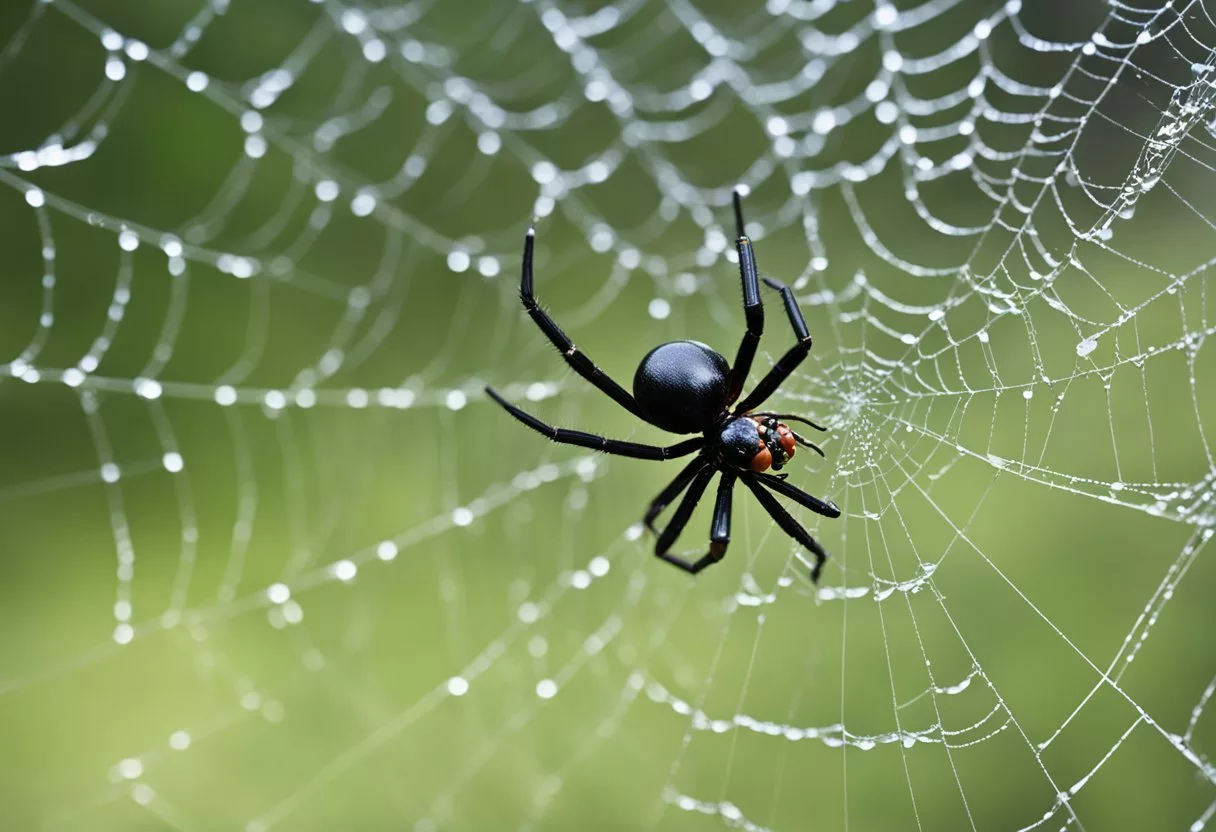
A black widow spider bite rarely leads to death. In most cases, people recover fully with proper medical care.
Pain from the bite can last for several days to weeks. Some people may experience muscle aches for months after the bite.
Possible complications include:
- Severe muscle pain and cramping
- High blood pressure
- Nausea and vomiting
- Difficulty breathing
- Seizures (in rare cases)
Children, elderly people, and those with health issues are at higher risk for serious complications.
In extremely rare cases, untreated bites can be fatal. This is more likely to happen in very young children or people with weakened immune systems.
Most patients recover without long-term effects. However, some may need ongoing treatment for pain or other symptoms.
Prompt medical attention is key to a good outcome. With proper care, most people fully recover from black widow spider bites within a few days to weeks.
Preventive Measures
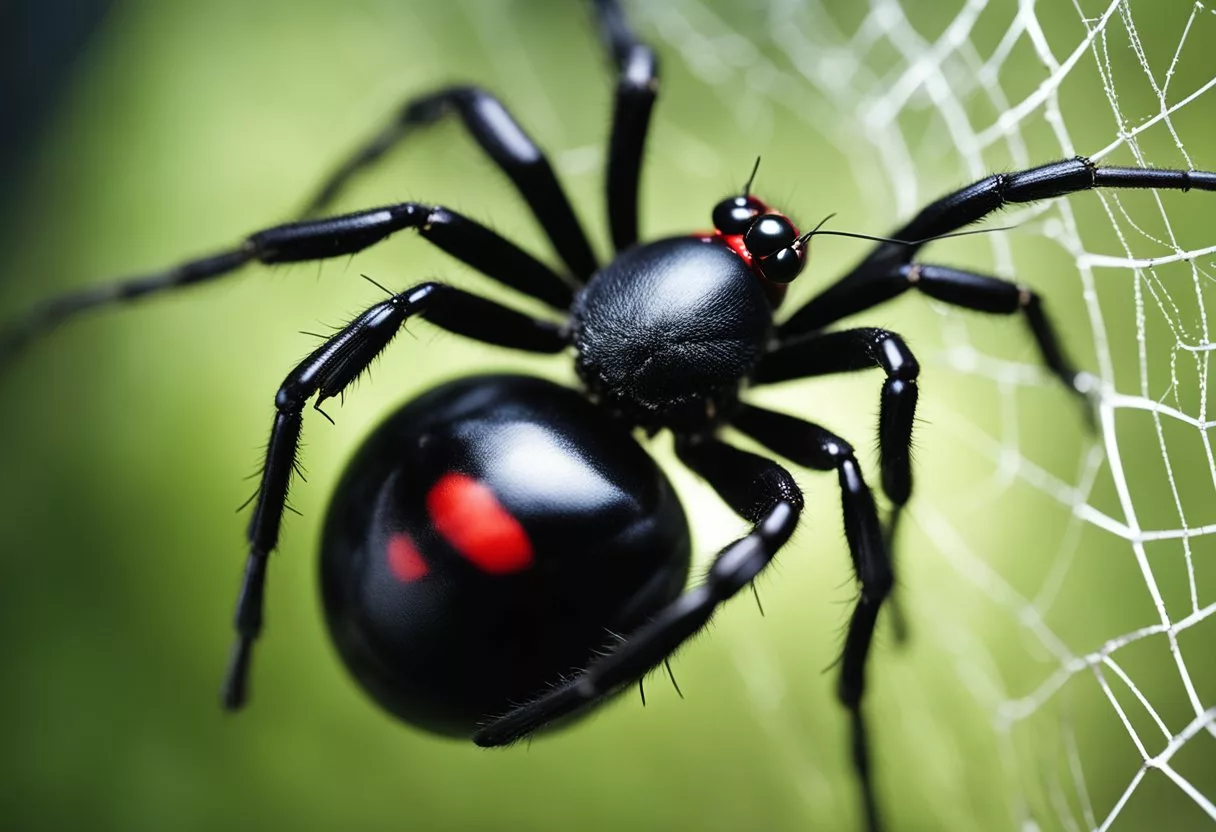
Taking steps to avoid black widow spider bites is key. Simple actions can greatly reduce your risk of encounters with these spiders.
Avoiding Spider Habitats
Black widow spiders like dark, quiet spots. Stay away from woodpiles, sheds, and cluttered areas. These places are perfect for spiders to hide.
Check shoes and gloves before putting them on. Spiders may crawl inside for shelter. Shake out stored items before use.
When working in the garage or basement, be extra careful. These are prime spots for black widows. Use a flashlight to check dark corners and crevices.
Protective Clothing and Gear
Wear long sleeves and pants when working outside. This creates a barrier between you and spiders.
Put on thick gloves when moving wood or rocks. Leather gloves work best. They’re hard for spiders to bite through.
Tuck pants into socks or boots. This stops spiders from crawling up your legs.
Wear closed-toe shoes when outside. Avoid going barefoot, even indoors.
Pest Control and Environmental Management
Keep your home and yard tidy. Remove piles of boxes, newspapers, and other clutter. These make great hiding spots for spiders.
Seal cracks and gaps around windows and doors. This keeps spiders out of your house.
Use sticky traps in basements and garages. These catch spiders without chemicals.
Trim bushes and grass near your home. This removes spider habitats close to where you live.
Clean up spider webs when you see them. This makes the area less inviting for new spiders.
Interaction with Black Widow Spiders
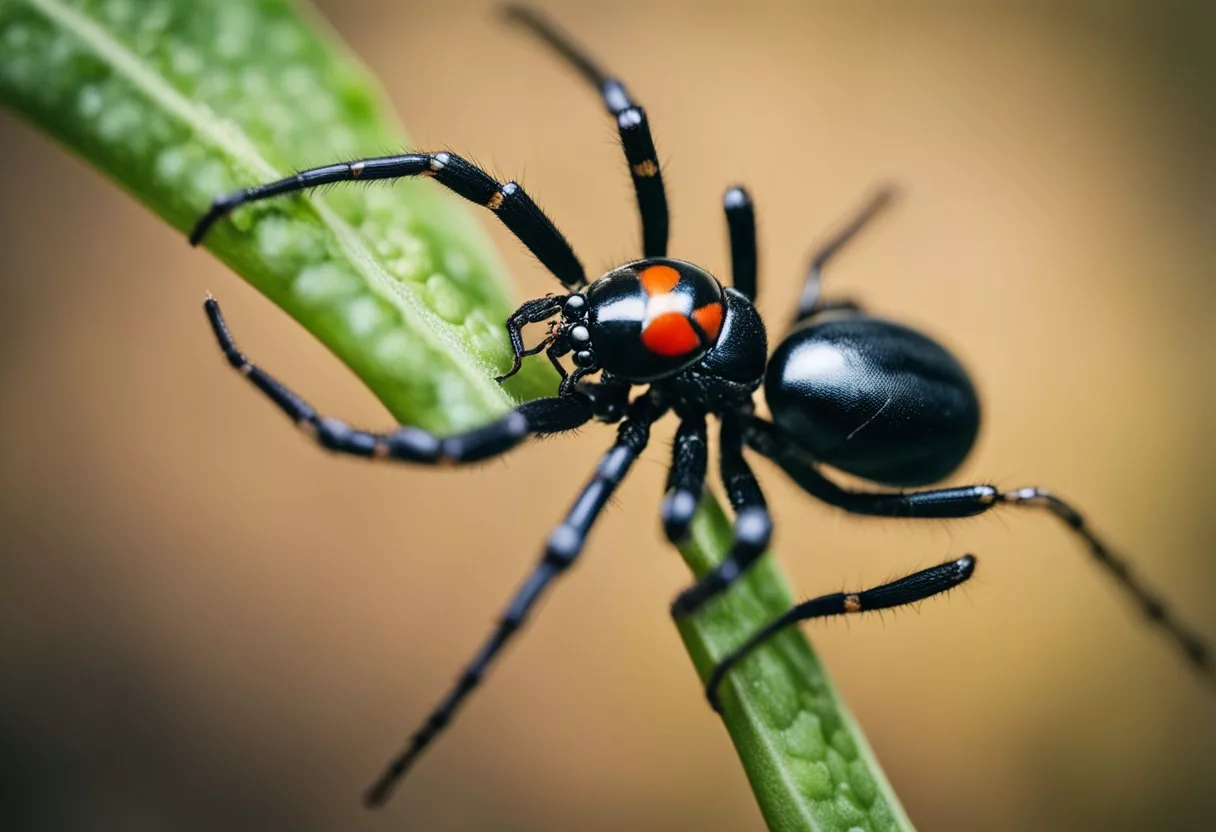
Black widow spiders are known for their potent venom and distinctive appearance. They have specific behaviors that affect how they interact with humans and other creatures.
Understanding Black Widow Behavior
Black widow spiders are not typically aggressive. They prefer to avoid confrontation when possible. These spiders are mostly active at night, hiding in dark, quiet places during the day.
Female black widows are larger and more dangerous than males. They often stay in their webs, waiting for prey. Males move around more, especially when looking for mates.
Black widows build messy, irregular webs. These are usually close to the ground in protected areas. The spiders use their webs to catch small insects and other prey.
Response to Threats
When threatened, black widows try to escape first. They may play dead or drop from their web. If cornered, they might bite as a last resort.
Black widows are more likely to bite if:
- Their web is disturbed
- They’re squeezed or pressed against skin
- A female is guarding her egg sac
Bites often happen when humans accidentally disturb a spider’s habitat. This can occur when reaching into dark spaces or moving objects where spiders hide.
To avoid bites, it’s best to:
- Wear gloves when working in areas where spiders might live
- Shake out shoes and clothes before putting them on
- Be careful when moving stored items or firewood
Frequently Asked Questions
Black widow spider bites can cause serious health issues. People often have questions about the symptoms, treatment, and recovery process. Let’s address some common concerns.
Can a black widow bite be fatal?
Black widow bites are rarely fatal. Most people recover fully with proper treatment. Deaths from these bites are very uncommon, especially with modern medical care.
What do the progression stages of a black widow bite look like?
The bite starts with two small puncture marks. Pain and swelling follow quickly. After a few hours, the pain may spread to other parts of the body. Muscle cramps and stiffness can develop within 8 hours.
What immediate steps should be taken after being bitten by a black widow?
Get medical help right away. Stay calm to slow venom spread. Put ice on the bite area. Do not use a tourniquet.
What are the typical symptoms following a black widow spider bite?
Symptoms include pain, redness, and swelling at the bite site. Other signs are muscle rigidity, nausea, and high blood pressure. Some people may have severe abdominal pain or trouble breathing.
When is it necessary to seek medical attention after a black widow bite?
Seek medical care for any suspected black widow bite. Immediate attention is crucial if you have severe pain, breathing problems, or other worrying symptoms.
How does one typically recover from a black widow bite?
Recovery often takes a few days to a week. Pain and other symptoms usually improve within 24-48 hours with treatment. Rest and follow-up care help ensure full recovery.